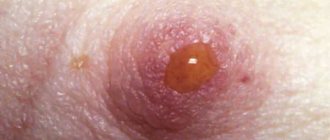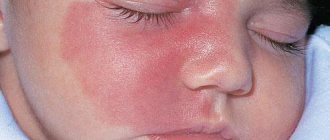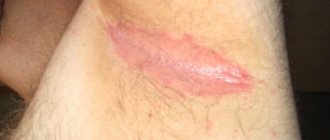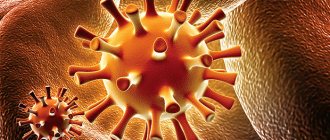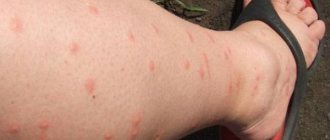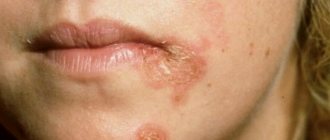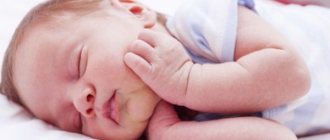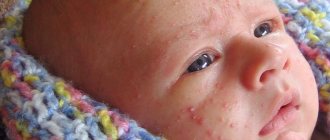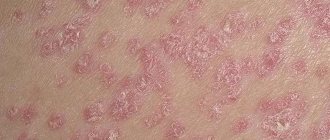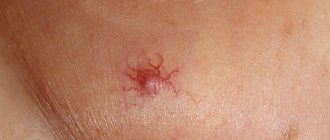In this article:
When small red spots appear on the baby’s skin, mothers begin to anxiously go through the options of what the baby may be allergic to on the body. They remember what they ate in recent days, what children's hygiene products they used, and with whom they came into contact.
But not all dermatological problems on the body are a manifestation of allergies in infants. Therefore, to determine the cause of skin rashes, you need to visit a doctor. An experienced specialist, based on an external examination, as well as additional laboratory tests, will determine the source of the rash and select treatment methods.
What does an allergy look like in infants and what else is similar to it?
A few weeks after birth, the baby develops red spots, which parents often mistake for a manifestation of an allergy on the body. Any competent pediatrician will explain to a young mother that these appear due to hormonal changes in the child’s body.
At one month of age, the child develops hyperemic spots on the face, neck, and sometimes on the back. The occurrence of such a sign indicates that the baby’s body is freed from maternal hormones and begins to produce its own. All this leads to an imbalance in the body, which is manifested by skin rashes.
After 2-3 weeks, when hormonal levels are restored, the rashes disappear. This condition is called newborn acne or three-week infant rash.
New parents assume that this is how allergies manifest themselves in newborns, because spots appear on the face, body, or even the butt. she begins to limit herself and follow a diet, but all her attempts do not bring results, because the hormonal rash has no connection with what a woman who is breastfeeding eats. Acne disappears as suddenly as it appeared, so no specific treatment is required.
How to distinguish allergies in a baby on the body from other types of rashes?
Dermatitis of allergic etiology is characterized by the appearance of accompanying symptoms, in addition to the rash:
- the skin becomes rough and dry;
- the child becomes restless, is capricious a lot due to the itching that bothers him;
- there is a change in the color of stool;
- in some cases a cough appears.
There are many signs, but they are all individual, as they depend on the reactive characteristics of the child’s body.
There are several types of allergic reactions:
- True allergy
- external signs of hypersensitization of the child’s body appear a couple of hours after contact with the causative factor. In the case of food allergies, skin rashes occur when the body accumulates excessive amounts of the allergen. This usually happens after 2-3 days, and redness on the skin cannot be eliminated quickly. Manifestations can last about 1-2 weeks after the nursing mother excludes from the menu foods that cause a specific reaction in the baby. - Infectious allergy
- its occurrence is provoked by pathogenic microflora. Most often these are staphylococci or streptococci. Skin rashes are also caused by viral infections that are inherited from the parents to the child. - Atopic allergy
- develops when the baby’s genetic history is burdened with hypersensitivity reactions, and the baby develops a rash on the body after contact with food, respiratory, household or medicinal antigens. Allergies in infants are manifested by spots on the face or body, long-lasting diaper rash on the bottom, itching or dry skin.
Allergies in a child on the legs and rashes on the skin of the body
Manifestations of an allergic reaction are varied - from a runny nose, watery eyes, sneezing, coughing fits to anaphylactic shock with the threat of suffocation.
An allergy is the body's response to any irritant and occurs in children of all ages.
Parents, having noticed a rash on their child, immediately think about how to treat the rash? The treatment regimen depends on the causes that led to the pathological condition, as well as the existing symptoms.
Types and causes of allergies in children
Most often, allergic rashes in children are observed due to close contact with an irritant. A symptom of an allergy is not only the appearance of a rash, but also itching, burning, and runny nose. Localization location – any.
Important: the younger the child is, the greater the danger the allergy poses to his health.
Main allergens: food products, medicines, house dust, insect bites, pollen, household products.
Allergic rashes in children are of the following types:
- A food reaction manifests itself in the form of diathesis. It poses a certain danger if left untreated - various pathologies of the digestive and gastrointestinal tract. Treatment consists of eliminating the allergen and a healthy diet;
- A drug reaction is the body’s immune response to interaction with any medications. Signs: skin rashes, itching, burning, runny nose, swelling of the tongue, lips or entire face. It is necessary to identify the provocateur medication and exclude its use;
- Aeroallergy is provoked by external factors characterized by a high degree of allergenicity. These include plant pollen, animal hair, insect poison, and molds. Laboratory tests will be required to determine the cause. Depending on the etiology, subsequent therapy is prescribed.
Children with weak immune systems are susceptible to harmful factors. There is often an interaction between several causes, which leads to the active release of histamine into the blood and a severe course of the pathology.
Forms of manifestation of an allergic reaction
What does an allergic rash look like? Symptoms can manifest themselves in different ways: a rash accompanied by severe itching and burning, red scaly spots, the appearance of blisters with cloudy or transparent contents. However, there are other changes in the skin.
Hives
The etiology of urticaria is based on food products, medications, household chemicals, and cosmetic care products. Occurs due to frost, exposure to ultraviolet rays, insect bites and other factors.
Blisters that are red or pink appear on the skin of children. The spots can grow larger over time and become itchy and itchy. The rash does not stay in one place and constantly migrates. Redness may appear on the legs, head, inner thighs, on the face - cheeks, near the lips.
Dermatitis
The atopic form of dermatitis manifests itself in newborns and can bother a child up to 3 years of age. The reasons are a combination of exposure to allergens and associated factors - chronic pathologies, hereditary predisposition.
For your information, dermatitis is a chronic skin disease - exacerbations are followed by periods of remission.
Characteristic manifestations:
- Itching and burning (intensified at night).
- Papules, the opening of which leads to the formation of crusts.
- Weeping, painful cracks.
- Pimples with purulent contents.
In young children, dermatitis most often appears on the face - forehead, cheeks, chin or knees. The occurrence of a rash on other parts of the body – on the thighs, arms – cannot be ruled out.
Contact dermatitis develops in the area where there was contact with the allergen. The symptoms are similar to an allergic reaction. Avoiding contact with the irritant eliminates the alarming symptoms. It most often appears in infants on the hips, arms, back, and armpits.
Eczema
A chronic disease manifested by skin rashes of various shapes and colors in children. In medical practice, there are three types - seborrheic, microbial and true eczema. Initially, signs appear on the face, and only then does the allergy appear on the child’s legs.
An allergic reaction can be triggered by any irritant - washing powder, food, medicine, etc.
Reasons depending on location
Visually, you can determine the pathology of the baby in accordance with the nature of the rash and location. However, the final diagnosis must be made solely by the doctor after a physical examination and examination. He will also tell you how to treat pathological manifestations.
Possible causes depending on the location of the rash:
- Face. If irritation, redness, swelling, itching appears on the face, accompanied by sneezing and runny nose, this is an allergy. It can be caused by food, insect bites, chemicals;
- Ears. The appearance of spots signals the development of dermatitis, poor child hygiene, seborrhea or candidiasis;
- Back. In most cases, the rash is similar to a nettle burn and is always very itchy and itchy. This is how an allergy to food or synthetic clothing manifests itself;
- Neck. Spots on the neck indicate prickly heat. Proper care and hygiene measures will solve the problem.
- Breast. If there are rashes in this area, infectious diseases are suspected - rubella, chicken pox (as in the photo), scarlet fever. It is possible that this is how contact dermatitis manifested itself;
- Hands and feet. Redness on the extremities indicates an allergic reaction. The spots can be separate from each other or merge.
Advice: if the rash on the thighs has the shape of stars and is accompanied by an increase in temperature, you need to call an ambulance. Such manifestations are characteristic of meningitis.
Drug treatment
Depending on the etiology of the occurrence of pathological elements on the skin, external and intravenous preparations are recommended. You can treat an allergic rash in a child at home, but the therapy regimen is prescribed only by a doctor.
Antihistamines
Recommended for acute allergies, as well as to prevent exacerbations. The child is prescribed medications that do not have a sedative effect - they do not cause drowsiness, lethargy, apathy, or lethargy. Usually these are second and third generation drugs.
Prescribed:
- Fenistal drops for the treatment of urticaria, food and drug allergies, allergic rhinitis in infants and older children. Can be taken from the first days of life.
- Zyrtec drops relieve symptoms of urticaria and atopic dermatitis. Suitable for use only from six months.
Young children are more often prescribed drops or syrups for internal use. Older children can be given tablets.
Topical hormonal medications
Prescribed only for extensive lesions of the skin. Hormonal substances included in creams and ointments effectively relieve rashes and itching. Improvement is observed after 2-3 uses.
Important: medications with hormones can be addictive and cause dangerous side reactions, as well as allergies.
First class drugs:
- Prednisolone ointment. Indications: mild dermatitis. Use on any area of the skin. Contraindication – up to 2 years of age;
- Hydrocortisone cream. The indications are similar. Prescribed from 6 months.
In the absence of a therapeutic effect due to the use of first-class drugs, the 2nd or 3rd generation is prescribed.
Other medicines
Non-hormonal medications have an antiseptic and moisturizing effect and provide a regenerating effect. Children are prescribed Gistan, Bepanten, Solcoseryl, Pantoderm. If a secondary infectious process has occurred, antibacterial and antifungal agents are recommended. Used only as indicated, for a short period of time.
When the cause of the rash is a parasitic disease, anthelmintic medications are prescribed; When the body is intoxicated, enterosorbents (activated carbon) are needed.
Herbal medicine for allergies
Baths and compresses based on medicinal plants help overcome itching, rashes, burning and other skin manifestations. They help eliminate only the consequence, but do not in any way affect the causes of the pathological condition.
Recipes for allergic reactions:
- A chamomile-based decoction is used as baths or lotions. For 1 liter of boiling water add 4 tbsp. l. chamomile, steam for 15 minutes. Cool.
- Decoction of succession. Add 1 tbsp to 250 ml of boiling water. l. Chopped plant. Leave for 10 minutes. Add to bathing liquid. The sequence gives a drying effect.
- A decoction of calendula inflorescences is used as a compress on the affected areas of the skin. Steam a pinch of flowers in a glass of water, leave and filter.
The use of traditional medicine must be discussed with a doctor. The child’s body may react unpredictably - the symptoms will intensify, which will only worsen the picture of the disease.
Children's rashes come in various forms. In some situations, treatment is not required, in other cases it is necessary to take medications and use hormonal drugs. The main thing is to pay attention to your child and contact a medical specialist at the slightest skin manifestations.
Source: https://IDermatolog.ru/allergiya/syp-u-rebenka-chem-lechit.html
Why does allergies appear on the body?
Allergies on the body of an infant develop as a result of contact with a substance that provokes it.
It could be:
- Dust
. Frequent cleaning of the apartment, cleaning carpets with a vacuum cleaner, regular wet cleaning of the floor and other places where dust particles accumulate will reduce the likelihood of developing sensitization in the body. - Cosmetics
. For use in children, choose special children's products that do not contain dyes, parabens, sodium sulfate and other preservatives and stabilizers. - Wool
. Pets often cause allergies in children. As infectious disease doctors advise, you should not get a cat or dog at the time when you have a child, as their hair can cause a severe allergic reaction not only on the skin, but also lead to bronchospasm or the development of bronchial asthma. - Unremoved residues of household chemicals
. This can be powder on clothes after washing, detergent on cups and plates, various solutions for washing floors, cleaning furniture.
Many parents assume that the development of hypersensitivity occurs due to errors in the diet of a nursing mother, which may cause allergies in infants on the body. Regarding whether a woman who is breastfeeding should strictly adhere to a hypoallergenic diet, doctors' opinions are divided.
Old-school pediatricians insist that everything a mother eats goes into the baby’s body with milk, so from the first days after birth until the end of lactation, they advise eliminating many foods that can trigger allergies.
The younger generation of doctors is of the opinion that the diet of a nursing woman does not play an important role in the occurrence of allergic reactions in an infant. It is much more important in what conditions the child lives and how often he comes into contact with what may cause an allergic reaction on the baby’s body.
There is some truth in each of the statements, so the mother should stick to the golden mean:
- In the first month after the baby is born, follow a diet that excludes foods that are allergens.
- If the child does not experience any negative reactions (skin rash, itching, peeling), begin to gradually introduce additional products into your menu.
- When expanding your diet, follow the rule - try no more than one new product per day, starting with small quantities.
In most cases, by the time the baby is three months old, the mother can eat well, sometimes allowing herself favorite treats such as chocolate, some fruits or a spoonful of honey, provided that the baby is not allergic to these foods.
If the baby is allergic from the first days of life, then the mother needs to give up some food groups:
- citrus fruits – tangerines, oranges, lemons;
- chocolate and chocolate candies;
- nuts in any form;
- smoked meats;
- conservation.
In addition, you should be careful when consuming products that contain artificial colors, preservatives and other harmful additives: bright carbonated drinks, packaged flavored teas, chips, crackers with various flavors and other products.
Allergic rash in children: photos, description and varieties
If you don’t know the difference between infectious skin diseases and allergic rashes in children, photos of these pathologies will help you distinguish one from the other.
In this article we will talk in detail about allergic rashes, their characteristic signs and methods of treatment.
For what reason does an allergic rash appear on a child's skin?
Skin rashes often appear in children from birth to 7 years of age. This is largely due to the fact that during this period the immune system of infants is still developing.
Disturbances in its functioning are often accompanied by swelling, hyperemia (redness of the skin) and/or rash.
Most often, an allergic rash appears due to:
- medications (the child’s body may react negatively to individual components included in the medications);
- breastfeeding if the mother does not follow a diet (for example, she is fond of chocolate, citrus fruits, honey, strawberries);
- household chemicals (washing powder, baby soap or baby cream, dishwashing liquid);
- allergic dermatoses (plants or animals, prickly or poisonous);
- natural factors (for example, prolonged exposure to the sun);
- infections (non-cellular infectious agents).
The rash may appear only on the face or spread throughout the body.
Rash on a child's face photo
What does a child's skin allergy look like?
Allergic reactions in babies can vary. Depending on what caused it, you have to deal with a food allergy or a viral one.
In many cases, exanthemas appear on the child’s body (this is the name given to various manifestations of allergic rashes):
- pustules (filled with pus);
- plaques;
- spots;
- vesicles (filled with liquid);
- blisters (large vesicles larger than 0.5 cm).
With food allergies in children, the rash can be found primarily on the cheeks and near the mouth. If the allergy is contact, then the rash will appear in the place where the allergen touched.
If the baby's immune system has reacted negatively to plant pollen, then instead of acne there may be hyperemia (redness) and swelling of the face.
A photo, better than any words, will allow parents to understand what an allergy looks like and what they may encounter. We will give a brief description of some types of allergic rashes that appear in children under one year of age and older.
Rash on a child's legs
| Type of rash | a brief description of | Cause |
| Allergic dermatitis | A small red rash spreads throughout the body. In these places, the skin becomes dry, peeling, cracks, and ulcers may occur. | Weak immunity or contact with an irritant. |
| Hives | Outwardly, it resembles blisters that appear after contact with the prickly plant of the same name. The rash “wanders” throughout the body, appearing on the hands, then on the face, then on the bends of the arms and legs. It may be accompanied by itching, but there is no relief after scratching. | The reaction of the child’s body to certain foods (chocolate, honey, eggs, citrus fruits). |
| Neurodermatitis | Externally it resembles psoriasis. Characteristic signs are severe peeling. May become chronic. | Food allergies, weak immunity. |
| Eczema | Small red ulcers or small pimples. It is a chronic form, so it can disappear and then reappear. Appears first on the face, then on the arms and legs. | Infectious diseases, household chemicals, dermatitis. |
Allergies to foods (sweets, citrus fruits), medications and antibiotics manifest themselves in different ways. The following table will help you figure out what is what:
| Allergen | Nature of the rash |
| Sweets (chocolate (peanuts, sugar, milk powder) and honey) | Pimples, hives, and small rashes around the mouth appear. With sugar intolerance, a small patient develops spots that itch very much. If you are intolerant to honey, you may experience swelling, thirst, difficulty breathing, red spots on the face. |
| Medicines | Red spots resembling a mosquito bite appear at the injection sites or on the arms, legs, stomach and back of the baby (if the medicine was instilled into the child’s mouth). Sometimes they swell and begin to itch very much. If spots and pimples appear on the feet and palms, then this is an infection and will require other treatment. |
| Antibiotics | A child's reaction to antibiotics appears immediately after taking the drug. An allergic rash in the form of red spots covers the baby's face and body. These spots do not itch, unlike contact dermatitis. Sometimes there is a temperature (appears for no apparent reason). Instead of stains, bubbles with liquid inside may appear. |
How to diagnose allergies?
An allergic rash in children is often confused with an infectious one. If the treatment is incorrect, then the consequences of such a therapeutic course will not be the best.
Before choosing an effective remedy, you need to learn to distinguish one disease from another. Only a doctor can make an accurate diagnosis, since a visual examination is not always enough to determine the cause of the disease; tests are required.
Variants of allergic rash
The differences between an allergic rash in children and an infectious disease are presented in the table:
| Features | Allergic rash | Infection |
| General form | It can be in the form of both small dots and large blisters. In addition to them, there are often crusts, erosions and serous wells (ulcers from which fluid oozes). | The rashes are pinpoint and do not “merge” into a large spot. |
| Place of appearance | Face (forehead, cheeks, chin). Neck, arms, legs, buttocks. Rarely – stomach, back. | Belly, back. Rarely – arms, legs. Very rarely - forehead. |
| Heat | The temperature is rare, and if it rises, it is not higher than 37-38°C. | The disease is accompanied by fever, from 37°C to 41°C. |
| Itching | Happens. | Happens. |
| Swelling | Well visible. In some situations it is life-threatening. | They happen very rarely. |
| Associated symptoms | Lacrimation, conjunctivitis, hyperemia of the mucous membrane of the eye, decreased blood pressure, cough, upset stomach. | Running nose, general loss of strength, body aches. |
| How quickly it goes | Often the rash goes away immediately after taking the medicine. | Remains until the course of treatment is completed. |
What medications are used to treat allergic rashes?
If children develop an allergic rash on their skin, it is strictly forbidden to squeeze pimples or open blisters. It is necessary to explain to the child that it is also forbidden to scratch the sores.
If he is still too small, make sure that he does not touch the wounds with dirty hands. He can get an infection, and this will only worsen his condition.
Treatment of rashes in children is selected depending on the type of disease. Parents who do not know how to treat allergic rashes in children should not select medications on their own.
Allergic rash on the body of children photo
We have listed the medications that the doctor may recommend in the following table:
| Allergic rash | Medications | Non-drug treatment |
| Allergic dermatitis | To relieve symptoms, Suprastin or Erius are prescribed. | Eliminate contact with the irritant. Bath the child in water with the addition of chamomile or sage infusions. Physiotherapy, rest and positive emotions will also help the baby. |
| Hives | Children are prescribed antiallergic drugs: Suprastin, Tavegil. | |
| Neurodermatitis | The doctor recommends:
| |
| Eczema | They help a lot:
|
How quickly does an allergic rash go away in children?
There is no clear answer to the question of how long it will take to fight allergic rashes in children. Much depends on the type and nature of the disease.
For example, a food allergy, if it appears in an infant or a one-year-old baby, goes away within one week. It is enough to simply remove the allergenic product from the diet of a nursing mother.
Those children who develop urticaria or allergic dermatitis will have to suffer for seven days. It is more difficult to fight eczema and neurodermatitis.
These diseases last for 14 days and often become chronic. This means that an allergic reaction may occur more than once.
Treatment should begin at the first appearance of a small, pale rash. If you don’t pay attention to it in the hope that “everything will go away on its own,” then the therapeutic course may drag on for a long time and turn out to be ineffective.
Allergic rashes photo
What is done to prevent allergic rashes in children?
Preventive measures will prevent the child from developing an allergic rash. Doctors give the following recommendations:
- Make sure that the baby does not come into contact with the allergen (remove allergenic foods from his diet; if necessary, change baby powder, soap or dishwashing liquid.
- Maintain order in his room, regularly do wet cleaning.
- If there are pets in the house, keep them clean.
- Strengthen the baby’s immunity (walk more often, play sports).
- Do not violate your doctor’s recommendations for taking medications.
Hives on a child's body photo
Causes of allergies
In the mother's womb, the child is in sterile conditions. After birth, his body gradually begins to be populated by microflora and come into contact with various types of allergens. Sometimes the result of this interaction is an allergy on the body in infants, when red spots appear on the face, neck and butt.
The baby’s protective functions are not yet fully formed, as a result of which even minimal contact with an irritant that would not lead to consequences in an adult can provoke the occurrence of hypersensitization.
Causes of skin allergies in infants:
- Genetic predisposition
. If at least one of the parents suffers from hypersensitivity to certain types of irritants, then there is a high probability of allergic reactions in the child, since this is inherited. - Treatment with antibacterial drugs
. If an infectious disease occurs in a baby, antibiotic therapy may be necessary. The drugs eliminate not only the pathogenic microorganisms that caused the disease, but also negatively affect the natural microflora of the gastrointestinal tract in the infant, which leads to increased sensitivity to various types of allergens. - Vaccination
. It happens that for vaccinations drugs are used that have a wide range of side effects, one of which is the occurrence of allergies. - Untimely feeding
. Belated application of the baby to the mother's breast can provoke disruptions in the gastrointestinal tract. - Errors in the nutrition of a nursing mother
. If the baby is predisposed to allergic reactions, the mother should adhere to a hypoallergenic diet, which excludes the consumption of nuts, citrus fruits, honey, as well as some other types of products, because allergens from the female body reach the child through milk. An unformed immune defense is not able to cope with them, as a result of which a corresponding reaction occurs. - Inappropriate
. Most formula feeding products contain caseins and albumins from cow's milk. These foreign proteins are strong allergens, so some children react to consuming such a mixture by developing itching and rashes on the skin. To solve this problem, choose one that contains protein hydrolysates, or buy artificial nutrition made from goat milk.
Behind the seeming harmlessness of an allergy that occurs on the skin of a baby, a serious and dangerous condition for a fragile organism is often hidden. Many mothers confuse pathology with diathesis (skin rash), so they hope that the spots on the baby’s body will go away on their own.
Untimely detection of allergies in an infant’s body delays the start of treatment, which can lead to hypersensitization at an older age.
Food allergies
An allergic reaction to food is caused by intolerance. In breastfed children, they can pass through mother's milk or as part of complementary foods. The most allergenic are eggs, citrus fruits, strawberries, store-bought products with chemical additives and many other products. Often, a child develops a food allergy during fetal development if a pregnant woman consumes highly allergenic foods.
Allergy to cow's milk protein in infants
Just as food allergies manifest in infants, almost all other types of allergic reactions can manifest themselves. This is due to the fact that all substances from the digestive tract are distributed throughout the body, causing a negative immune response in any of its organs. Pathology may appear in the form of the following additional symptoms:
- redness, itching, rash on the skin and mucous membranes;
- signs of allergic dermatitis and rhinitis.
Disorders of the gastrointestinal tract are often observed and the biochemical formula of the blood, determined by laboratory analysis, may change.
Useful video about allergies in babies
An acute reaction of the immune system to a certain substance or factor is called an allergy. This disease has not been fully studied, because it is almost impossible to understand why a particular organism reacts to any substance. The immune system can classify anything as a dangerous component. Most often, allergies manifest as skin lesions. Symptoms related to the skin and subcutaneous tissue usually appear first on the hands. This problem requires timely diagnosis and effective treatment.
Causes
Allergies in an infant can manifest themselves for many reasons. That is, there is, naturally, one reason, and it consists in a non-standard reaction of the immune system to a certain substance. However, there are many allergens that can cause such a reaction. The vulnerable body of a newborn, which has not yet had time to properly adapt to the phenomena of the outside world, is vulnerable to various manifestations of allergies. An allergic reaction on the hands can be caused by:
- certain foods consumed by a nursing mother,
- excrement and particles of saprophytes (microorganisms also called dust mites),
- a protein found in the structure of epidermal cells, dandruff, excrement and biological fluids of pets,
- some medications
- hay fever (reaction from plant pollen),
- washing powder and other household chemicals.
Symptoms
All diseases in newborns usually develop rapidly. This also applies to allergic reactions. An allergy to the hands of a baby may appear a few seconds after the penetration of the allergen. The skin rash on a baby's hands usually appears as blisters and resembles the marks left after contact with nettles.
Sometimes the skin reaction is eczema, or appears as scaly patches of varying sizes.
As a rule, all allergic rashes on the hands, no matter what they look like, are very itchy, so the baby is capricious, sleeps poorly, and behaves restlessly. Sometimes an allergic reaction in infants is accompanied by diarrhea.
Diagnosis of hand allergies in newborns
It is especially important to quickly determine the development of an allergic reaction in the hands of an infant. This will then allow you to identify the allergen and eliminate contact with it for further recovery. After all, this is the only way to get rid of allergies.
For the purpose of diagnosis, first of all, the patient is examined and the medical history is studied. The doctor finds out the following information: how long ago the signs of allergy on the hands appeared, when exactly, and whether this has happened before.
Children of the newborn period of life are not prescribed skin allergy tests, so laboratory diagnostic methods include a blood test for the content of class E immunoglobulins.
Sometimes it is necessary to consult a dermatologist.
Allergy to medications
The appearance of signs of allergies on the face of a baby is possible with the parallel treatment of some somatic diseases with the use of medications. Theoretically, any remedy can cause rash, itching and redness.
Before treating your baby with medications, you should definitely consult a doctor. When a characteristic clinical picture appears, it is often necessary to adjust the dosage or abandon a particular drug.
We suggest you read: Why the face swells in the morning after sleep
Complications
Allergies in the hands of a newborn are not uncommon. And if it’s just a rash on the hands, then there is no particular danger to the baby’s life. The baby will be restless and have trouble sleeping and eating, but such signs will go away with the elimination of the symptoms that bother the baby. The consequences of allergies are that urticaria can develop, in the absence of timely and effective therapy, into weeping eczema of a chronic course, and other allergic symptoms may be added to the skin reaction:
- the occurrence of allergic rhinitis,
- development of allergic conjunctivitis,
- breathing difficulties that can develop into bronchial asthma.
The most dangerous signs of allergies, which can lead to death, are:
- giant urticaria (Quincke's edema),
- anaphylactoid reaction of the child's body.
So any allergy, even just a rash on the hands, needs immediate professional treatment.
Treatment
What can you do
If a mother notices characteristic allergic rashes on her hands in her baby, the first thing she should do is make an appointment with a doctor. It may not be an allergy; an accurate diagnosis must be made in order to begin treatment, and only an experienced doctor can do this.
It is categorically forbidden to self-medicate your infant, in this way you can only harm the fragile child’s body, and you will still have to go to the clinic later, but with a more serious problem.
The only thing that can be done while waiting for an appointment with a specialist is to exclude the baby from contact with the allergen, if you can guess what was the provoking factor for the rash.
What does a doctor do
Having diagnosed an allergy, the doctor prescribes treatment appropriate to the patient’s age and condition. First of all, any specialist will strongly recommend getting rid of the allergen if it is dust, waste products and pet saliva. Or exclude some products that contain the identified allergen. Recommendations will be consistent with diagnostic data.
In this case, drug therapy is indicated, which is prescribed to eliminate the appearances on the hands that bother the baby.
As a rule, in case of an allergic reaction, newborns are prescribed topical steroids and topical medications, moisturizers that relieve itching and skin manifestations.
If the rash indicates a severe allergy, the doctor will recommend stronger medications, these are:
- antihistamines that need to be taken orally,
- corticosteroid drugs,
- hormonal creams and ointments.
The effectiveness of treatment requires the prescription of diet therapy, this applies to babies who are already trying complementary feeding, and mothers who are breastfeeding.
Prevention
newborn, in particular rashes on the hands. Possible preventive measures include the following:
- balanced nutrition for a nursing mother, the use of high-quality dry formulas, the gradual introduction of complementary foods,
- regular wet cleaning of rooms, timely removal of dust,
- the use of hypoallergenic detergent compositions, rinsing children's clothes,
- thorough ventilation of the children's room,
- using a humidifier,
- the use of children's clothing and diapers made from high-quality natural fabrics,
- compliance with hygiene rules (washing hands before contact with a baby, after going outside, contact even with pets).
Such preventive measures make it possible to reduce the risk of allergic reactions in a newborn child.
Unfortunately, allergies are becoming more and more common every year. In addition, children are increasingly susceptible to allergic reactions. Allergies to a child's legs are a fairly common occurrence, and the cause may be a variety of factors.
At its core, an allergy is a response of the body that occurs to provoking factors. Such factors can be anything - from the aroma of perfume to food products. As a rule, the response manifests itself in damage to the skin. No allergic manifestations should be ignored, especially if they occur in a child. If an allergy occurs, you must consult a doctor, find out which allergen caused the reaction and be sure to undergo a course of treatment.
Treatment of facial allergies in children.
Therapy for an allergic rash on the face of a baby begins with excluding the baby from contact with a potential antigen. In 50-60% of cases, symptoms regress on their own after this. If the allergy does not go away, then medical intervention may be required.
Medicines
Among medications for eliminating rashes on the face, various gels, ointments, and creams remain popular. Groups of drugs used to combat the symptoms of pathology:
- Antihistamines (Diazolin, Suprastin, Tavegil).
- Hormonal agents (prednisolone or hydrocorthione ointment).
Depending on the characteristics of the clinical case, the doctor may, if necessary, prescribe medications from other groups. Allergies are sometimes the result of a somatic disease or helminthic infestation. When the root cause of the problem is eliminated, its symptoms will go away on their own.
Traditional methods
Traditional medicine is an alternative treatment option for an allergic rash on the face of a child. Non-traditional methods are effective in the early stages of pathology, provided that contact with the allergen is avoided.
To eliminate symptoms, lotions with a decoction of string, bay leaf, and chamomile are well suited. The products have been known among the people for centuries and do their job perfectly. The main thing is to consult a doctor in time if the described treatment does not bring any effect, and the manifestations of the pathology progress.
To cure an allergy in an infant, you must first remove the allergen. When breastfeeding, a woman must choose her food carefully. Citrus fruits, honey and bee products, red fruits and vegetables, baked goods, chocolate, canned and smoked foods, milk, nuts, fish and seafood are completely excluded from the diet.
Causes of allergies
The main cause of allergic reactions is considered to be reduced immunity. This explains the frequent allergies in children - their immune system is not yet strong, and it does not work at full strength. It must be said that the causes of allergies are divided into two groups: endogenous - when the reaction manifests itself after the allergen enters the body and exogenous - when the allergy develops as a result of external factors.
Allergies in a child’s arms, legs, stomach, butt, back, and so on can occur due to:
- cold;
- medications;
- food products;
- pet hair;
- house or street dust;
- plant pollen;
- insect poisons;
- material for shoes and clothing.
In children with a hereditary predisposition to allergic reactions, atypical reactions occur more often. Also, allergies on the palms, feet, butt, around the eyes, and on the back can occur due to certain diseases, for example, with a fungal infection or with diabetes.
Prevention of allergies in children according to Dr. Komarovsky.
Allergy prevention involves preventing the child from coming into contact with possible antigens. It is sometimes impossible to ensure the specified moment. However, doctors highlight key aspects that will help minimize the risk of a rash on the face:
- Adequate nutrition for the mother during pregnancy.
- Eliminating the influence of negative factors on a woman during pregnancy.
- Limiting contact with medications, plants, and unwanted products in children.
- Timely contact a doctor if necessary.
Allergy to a child’s face is a problem that can be dealt with. It is important to determine the cause of an inadequate immune response in time, and then exclude contact with it. The main thing is to seek help from a doctor if you cannot solve the problem on your own.
Allergy symptoms
The child's body is extremely sensitive to even minor changes in the usual environment and diet. New products, unknown odors, etc. - the body can perceive all of this as aggressive substances, this happens because each of them contains a foreign protein, which causes a violent atypical reaction in the body. This reaction is manifested by the following symptoms:
- The tissues swell, tubercles, swellings, and blisters appear that rise above the skin surface and can be easily felt,
- Red spots appear on the palms or other areas of the skin, which can merge with each other, forming large areas. These spots cannot be felt - they do not protrude above the skin surface,
- Small or large pinpoint nodules can often be seen on a child’s neck or legs; they can also be grouped throughout the body, or form directly on red spots,
- Allergies to the eyes, more precisely around the eyes, are often accompanied by peeling, and blisters, eczema and various purulent formations may occur around the child’s mouth,
- An allergy to the butt in a child is accompanied by redness and swelling, while rashes may or may not be present.
- Most often, allergic manifestations are observed under the knees, in the armpits, on the back, in the elbow, on the hips and feet.
Quite often, skin rashes are accompanied by skin itching of varying intensity, the temperature may rise, vomiting and diarrhea may occur. If the disease manifests itself in acute form, then there is a risk of developing Quincke's edema, suffocation and anaphylactic shock.
Dangerous allergic symptoms
Quincke's edema is dangerous due to the likelihood of suffocation when the larynx swells
- Quincke's edema. It is rare in children, but the condition is very dangerous. Under the influence of an ingested allergen, the skin and areas rich in subcutaneous fat swell: lips, eyelids. Such external manifestations are painless and do not pose any danger. But if swelling of the larynx occurs, breathing becomes difficult. In this case, Quincke's edema becomes life-threatening.
- Anaphylactic shock. An instantly developing reaction upon repeated contact with an allergen to which the body has already been sensitized. May be caused, for example, by insect bites. In such a situation, attacks of suffocation, disorders of the central nervous system (loss of consciousness), as well as cardiovascular problems (weak thread-like pulse, low blood pressure) occur. If help is not provided immediately, brain swelling and death are possible.
- Erythema. Occurs when areas of the rash merge into one large, ulcerated spot. Deprived of a protective layer, it becomes a breeding ground for pathogenic flora, and purulent formations form.
Diagnosis of allergies
Only a doctor can diagnose allergies and differentiate them from other skin diseases. Therefore, you should not treat the child yourself, because without being a specialist, you will not be able to distinguish an allergy on the back from dermatitis or fungal skin lesions, and an allergy around the child’s mouth from manifestations of stomatitis or a herpes virus infection.
At an appointment with a doctor, a specialist, after examination and questioning, will refer the patient for an examination, which includes tests and analysis for immunoglobulins. It must be said that allergy tests are carried out only for children over five years of age. Provided that allergy is not an independent disease, but acts as a consequence of another illness, diagnosis and treatment of the underlying disease is prescribed. If for some reason it is not possible to identify the allergen, the doctor will suggest getting ahead of the irritant by elimination. Parents will have to eliminate the provoking factors one by one and monitor the child’s condition. In this case, it is recommended to keep a special diary, where you will need to enter information about the child’s contacts and nutrition every day, as well as describe the body’s reaction.
Parents should understand that allergies cause children perhaps even more discomfort than adults. In addition, a child’s allergies can become chronic and accompany him throughout his life. It is important to remember that allergies are especially dangerous, which, in addition to skin manifestations, are accompanied by respiratory lesions - some acute reactions of the respiratory tract can even lead to death.
But, even without respiratory manifestations, an allergy is dangerous - an allergy in the eyes, for example, can cause the development of conjunctivitis, and an allergy in the palms or other areas of the skin can provoke the development of dermatological diseases. In addition, by scratching itchy areas, a child can get an infection, which can cause various lesions not only of the skin, but also of internal organs.
Principles of treatment
For any allergy, the most important condition is to exclude the provoking factor. All medications for a child should be prescribed only by the attending physician, prescribing the drug itself and its dosage in accordance with the child’s age and the clinical picture of the disease.
To relieve symptoms, antihistamines are prescribed in most cases. These medications work by blocking receptors that are affected by the allergen. These can be not only oral medications, but also topical medications - Epidelili Fenistil. For very severe reactions, your doctor may prescribe hormonal medications.
Antihistamines are divided into generations; the first generation drugs are quite strong, however, they have a number of contraindications and side effects, and their period of action is short. Such drugs are rarely prescribed to children, since one of the side effects is depression of brain activity. These are the following drugs - Diazolin, Tavegil, Suprastin, Clemastin.
Second generation drugs are Claritin, Loratadine, Peritol, Allergodil. These drugs do not have a sedative effect and do not have serious side effects. But they can have negative cardiotoxic effects.
The safest antihistamines for children are third generation drugs. These medications do not affect heart rate, do not cause drowsiness, or have a depressant effect on the brain. These are Zodak, Cetrin, Telfast.
Allergies to a child’s bottom, legs, arms, and back can be treated quite well with these remedies; they can relieve unpleasant symptoms and prevent dangerous manifestations of allergies.
